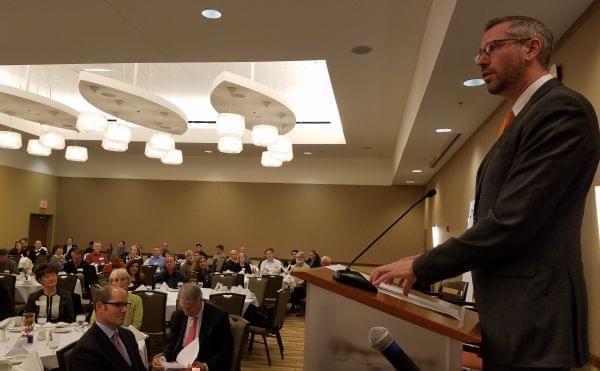State-Sponsored Retirement Savings Program Enters Pilot Phase

State Treasurer Mike Frerichs speaks to an audience gathered for a panel on saving for retirement at the University of Illinois I-Hotel. Jim Meadows/Illinois Public Media
It’s been more than three years since then-Governor Pat Quinn signed legislation creating the Secure Choice program. But the retirement savings program for workers whose employers don’t offer one is finally becoming a reality.
Under Secure Choice, Illinois employers with 25 or more workers must offer their own retirement savings program, or offer Secure Choice, which automatically channels five percent of workers’ paychecks into a Roth IRA.
However, State Treasurer Mike Frerichs says employers always have the option of adjusting the amount of money they withhold, or the type of financial plan — or they can opt out of the program entirely.
“This is not a state defined benefit program,” said Frerichs. “This is not Social Security. This is getting people the tools they need to invest in themselves, so that they have a brighter retirement.”
Frerichs discussed the Secure Choice program Wednesday at a panel on retirement savings at the University of Illinois’ I-Hotel in Champaign.
The Democratic treasurer says savings in the program are shielded from any state financial problems.
“This money will be kept in individual accounts, managed by an outside investment firm,” said Frerichs. “This money cannot be swept by state government, it cannot be used for state purposes. And it’s very important that the public knows that, so that they can have faith that their savings will be there for them when they retire.”
Frerichs says employers that volunteered for Secure Choice early are trying it out now in a pilot program. Other employers will be brought in beginning in the fall, with full participation expected by the end of 2019.
As state treasurer, Frerichs chairs the seven-member board that oversees the Secure Choice program. The board is scheduled to hold a meeting on April 19 at 9 AM, teleconferencing between Chicago and Springfield. Pennsylvania-based Ascensus, LLC is the program manager for Secure Choice. Ascensus also manages OregonSaves, a similar state-sponsored retirement savings plan in Oregon that was launched in 2017. While OregonSaves went into operation first, Frerichs says Illinois was the first to pass legislation for such a program.
As with Secure Choice, employees are free to opt out of the OregonSaves program, and Frerichs says the opt-out rate for that program “was not as good as we had hoped”. CNBC cites an opt-out rate among employees in Oregon of 21% after the first six months of the program. Still, Frerichs said the fact that most Oregon employees were staying with the program was evidence that making Secure Choice an opt-out, rather than an opt-in program was a sound idea.
“Because everyone knows they need to save for their retirement,” said Frerichs. “We just put if off because it’s too difficult, it’s complicated, it’s confusing, or I can’t put the money aside today. But when we help them take it out of their paycheck, where they don’t have to do anything, they don’t miss the money, most people continue to save. They stay in the program.”

